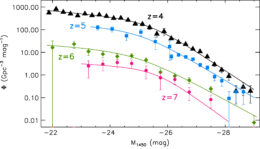Researchers have peered back to the first billion years of the universe to study the behavior of quasars. What they learned about the typical luminosities of quasars during that era can tell us about the role quasars played during the epoch of reionization.
Quasars in the Early Universe

Simulation of galaxies ionizing hydrogen gas (bright areas) during the epoch of reionization. [M. Alvarez (http://www.cita.utoronto.ca/~malvarez), R. Kaehler, and T. Abel/ESO; CC BY 4.0]
With the population of known quasars ever growing, researchers can begin to study the characteristics of quasars as a whole rather than focusing on single objects. This means we can probe the role that quasars played during the epoch of reionization: the period during which the universe’s neutral hydrogen gas was ionized by light from the first stars. Researchers are still debating precisely when reionization occurred, how long this period lasted, and which galaxies or cosmic objects contributed the most ionizing photons to the cause.

The quasar luminosity function from this work (magneta circles and black lines) compared to luminosity functions measured in other studies. Click to enlarge. [Adapted from Matsuoka et al. 2023]
Finding a Functional Form
Yoshiki Matsuoka (Ehime University) and collaborators studied a sample of 35 quasars around a redshift of z = 7, which corresponds to roughly 800 million years after the Big Bang. The team set out to determine the quasar luminosity function, which describes the number of quasars present at a given luminosity. If the function is flat, that means that quasars of all luminosities are equally common, while a top-heavy function is skewed toward bright quasars and a bottom-heavy function is weighted toward faint quasars.
Using data from Pan-STARRS1, the DESI Legacy imaging Surveys, the UKIRT/VISTA Hemisphere Surveys, the WISE survey, and the Subaru High-z Exploration of Low-luminosity Quasars (SHELLQs) project, the team found that the “knee” of the distribution is located at a magnitude of –25.6. The shape of the quasar luminosity function at z = 7 is similar to the shapes of the luminosity functions at lower redshifts, though there are fewer quasars at any given luminosity at z = 7 than at lower redshifts.
Reckoning with Reionization

The z = 7 quasar luminosity function determined in this work (magenta) compared to the luminosity functions at lower redshift. Click to enlarge. [Adapted from Matsuoka et al. 2023]
There will be more to learn about quasars’ role during reionization once we establish observatories and surveys capable of detecting substantial numbers of quasars even farther back in the universe’s history; the team noted that upcoming data from the Vera C. Rubin Observatory, the Nancy Grace Roman Space Telescope, and the Euclid space telescope will push the quest for quasars out to even higher redshifts.
Citation
“Quasar Luminosity Function at z = 7,” Yoshiki Matsuoka et al 2023 ApJL 949 L42. doi:10.3847/2041-8213/acd69f

